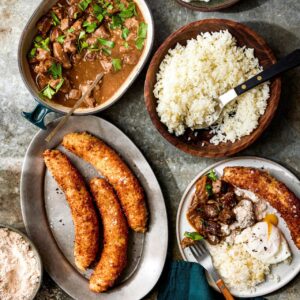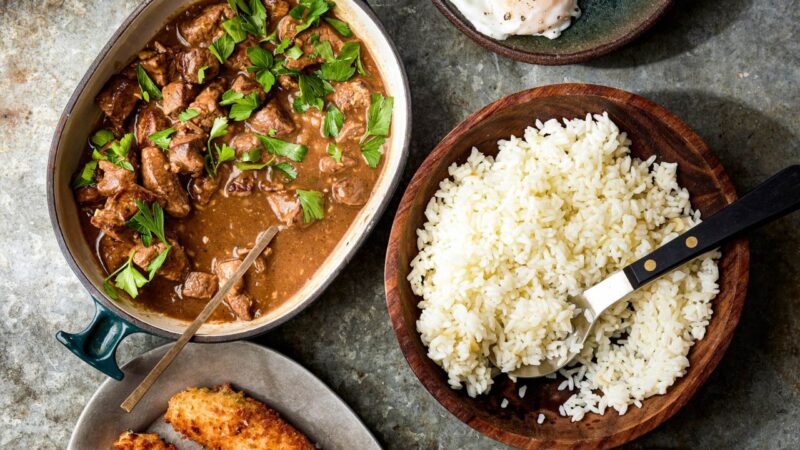Last Updated on January 27, 2025
Rio de Janeiro, Brazil, which sits on the coast facing the Atlantic Ocean, is known for its picturesque beaches, lush mountainous terrain, boulevards straddled by high rises of Modernist and Old World European architecture, and vibrant culture. It’s an extremely surreal yet recognizable urban landscape for a large nation with rich bio and cuisine diversity.
One diverse dish popularized in the mid-twentieth century at Rio’s Copacabana Palace hotel is called picadinho. The Portuguese word translates in English to “little chopped things,” and this Brazilian dish is made up of just that, little things. But little is almost a misnomer because the dish packs a set of big flavors. Picadinho is like a constellation of flavors and textures, all served together, for a complete, nutritious and fun meal.

Ingredients
For the farofa
- 3 tbsp unsalted butter
- 1/2 cup finely chopped yellow onion
- 3 garlic cloves, finely chopped
- 2 cups cassava flour
For the steak
- 2 8 ounce ButcherBox Beef Ranch Steaks, defrosted, rinsed and pat dry
- Salt and pepper
- 2 tbsp canola oil
- 2 tbsp unsalted butter
- 1/4 cup chopped shallots
- 4 garlic cloves, finely chopped
- 1 tbsp chopped thyme leaves and tender stems
- 1 tbsp all-purpose flour
- 1/2 cup red wine
- 1 cup beef, chicken or vegetable broth
For the crispy banana
- Canola or other high-heat appropriate frying oil
- 1/4 cup all-purpose flour
- 4 firm yet ripe bananas, peeled
- 1 large egg, beaten
- 3/4 cup panko or other coarse bread crumbs
For serving
- 4 poached eggs
- Warm rice seasoned with garlic and olive oil
Instructions
- In a medium non-stick skillet, make the farofa by heating the butter over medium heat. Once melted, add the onion and garlic and a pinch of salt and cook, stirring often until very soft, but not browned, for about 7 minutes. Stir in the flour and cook, stirring regularly until the flour is pale golden and tastes mildly nutty, about 7 to 10 minutes. Season with salt, turn off the heat and transfer to a small serving bowl.
- Slice the ranch steaks into ½-inch cubes, season with salt and pepper and set aside. Heat the canola oil in a large skillet (10 to 12 inches in diameter) over high. In two batches, sauté the steak cubes until browned and mid-rare in the middle, about 3 minutes per batch. Turn the heat down to medium-low, transfer the steak to a plate to rest and discard any oil left in the pan. Turn down the heat to medium
- Add the butter to the skillet and once melted, add the shallot, garlic and a pinch of salt, sauté, tossing until very aromatic and with browned edges, about 4 minutes. Mix in the thyme and flour, stir to coat everything with the flour and cook for about 2 minutes. Pour in the wine, stir, bring to a simmer, reduce by half so that the mixture is very thick and then pour in the broth. Bring to a simmer, reduce by about ½ then transfer the beef cubes back to the pan. Toss and stir to coat each beef piece, turn off the heat then set aside until ready to serve.
- Rinse and wipe the skillet clean to fry the bananas. Pour in about 1-inch worth of canola oil. Heat over medium-high to 350 degrees F and using an instant-read thermometer, toggle the heat to maintain the temperature while you prepare the bananas.
- Line one plate with paper towels, then add the flour to another plate. Pour the egg onto a third plate and add the panko to a fourth plate.
- Banana by banana, first dredge in the flour, then the egg (let excess drip off) and coat in the panko, covering each piece completely. In two batches, lay the battered bananas in the hot oil and fry, turning them halfway through, until golden brown, about 5 to 7 minutes. Transfer to the paper towel-lined plate and sprinkle with flake salt.
- When ready to serve, reheat the ranch steak picadinho, if desired (or if it has gotten cold), over medium-low heat until just hot. Then spoon on plates with the crispy bananas, garlic rice, poached eggs and a sprinkle of the farofa over the top.
Notes on Ranch Steak Picadinho from chef Phillipe Flores
“Traditionally, the dish uses beef tenderloin, which is cooked fast and hard just like this version with ranch steak,” chef Phillipe Flores says. The beef is hand chopped or cut into small pieces, another example of “little chopped things.” Those small pieces of steak are then sautéed quickly and served with a savory gravy. It’s important that the beef isn’t just ground beef, and it’s important to get small yet chewy bites. From there, perfect sides include eggs (fried or poached), rice, chopped greens like watercress, fried bananas or plantains and toasted cassava flour. This late-night party food is sharable, delicious and gives much needed sustenance.
Chef Flores, who grew up in Rio de Janeiro, cooked this dish at home and then eventually in professional kitchens like at the Transamerica Hotel in Rio. He makes his picadinho by first searing his beef cubes in butter until medium-rare, then to halt them from cooking more, transfers the cubes to a plate to rest while he makes a gravy-like sauce with flour, shallots and red wine. The wine is a star ingredient that he first learned to include while cooking at the hotel. The rich sauce eventually thickens and tightly hugs the “little chopped” beef cubes. He recommends adding some vegetables like “you might to a beef bourguignon,” such as mushrooms, onion and carrots, or even another non-vegetable like bacon. Once the beef is stirred back into the sauce, serve it immediately so the beef doesn’t keep cooking.
For sides, Flores likes the traditional ones like poached eggs with runny yolks that the garlic rice helps soak up. He also coats bananas in a dredge of flour, egg and breadcrumbs for a crunchy-sweet side that contrasts the deeply savory beef really well.
Lastly, Flores cooks cassava flour (which is also sometimes called manioc or yucca flour) over the stovetop with garlic and onion that’s sweated in butter until it becomes toasted and nutty. It’s akin to a dry spice mix that you can use to season the beef but also the eggs and rice.
Picadinho has a history of being comfort food that you’d serve after or during a night of drinking. First introduced by the Portuguese, picadinho was popularized in the bohemian nightclubs of Rio and then by the city’s Copacabana Palace hotel so much that it’s become a national dish.
ButcherBox’s Ranch Steak takes on the traditions and origins of picadinho thanks to chef Flores’ insight. The dish, of course, is a great late night food, but it’s also excellent for brunch or dinner.


